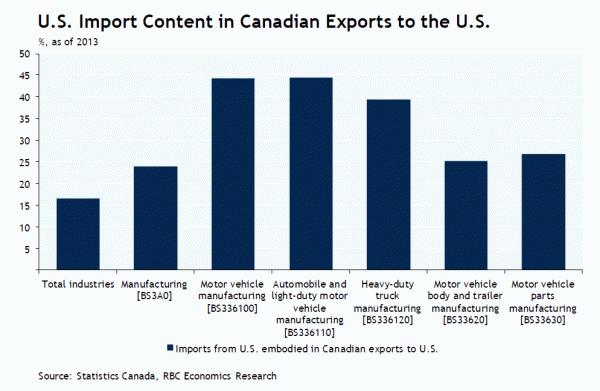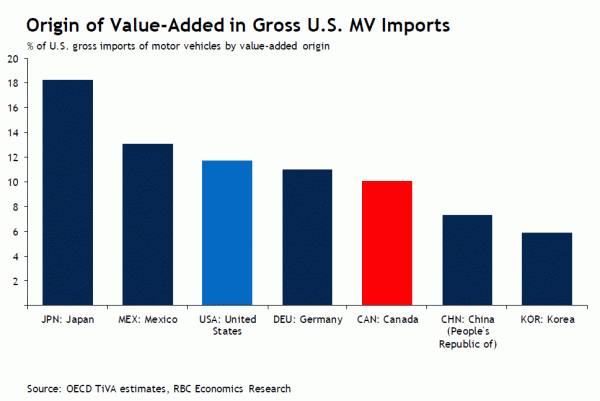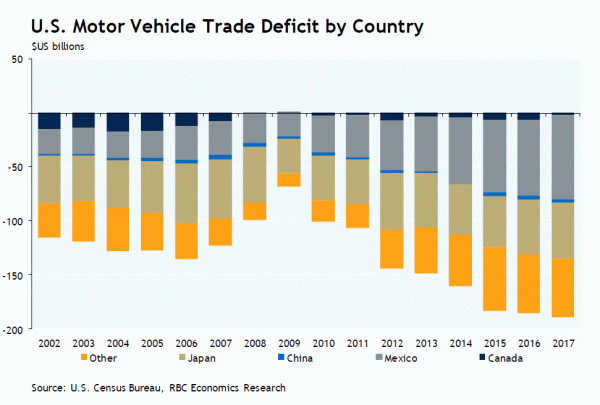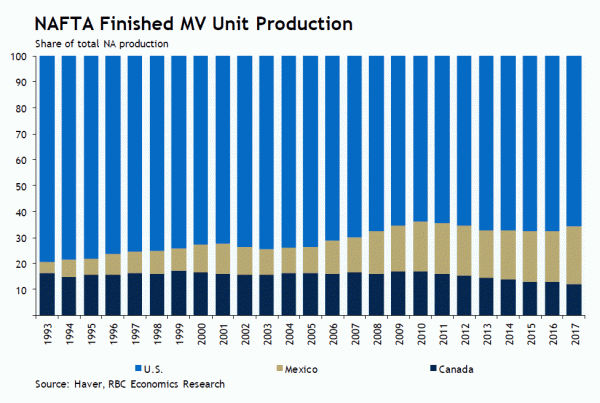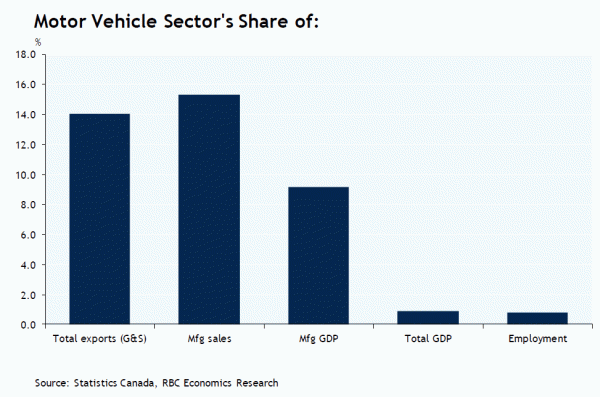The U.S. Commerce Department is considering imposing tariffs on U.S. auto imports, including from Canada. President Donald Trump is said to be eyeing tariffs in the 20% to 25% range. The ultimate decision on any tariffs (as well as the rate, countries targeted, etc.) will presumably depend on the findings of the Commerce Department’s investigation. While the investigation could last up to nine months, the department is reportedly aiming to reach a conclusion sooner.
This latest trade threat could mostly disappear if a NAFTA resolution is reached. And it’s hard to see any economic rationale for the U.S. imposing significant auto tariffs on Canada. Canada accounts for little of the U.S. auto trade imbalance and the tight integration of the North American auto sector means the U.S. auto industry would also be hurt. Nonetheless, if imposed, the U.S. tariffs would have a dramatic impact on the Canadian auto sector—and on Ontario, the centre of Canadian auto production—potentially lowering overall GDP in Canada by some 0.5%.
A U.S. auto import tax would hurt the sector it’s meant to protect
The proposed auto tariffs differ from earlier actual tariffs the U.S. imposed on products including steel, aluminum, and softwood lumber in that there are no clear winners from the U.S. perspective. The criticism of those earlier tariffs (correctly) was that they would directly protect specific industries but raise costs for other manufacturers using these products as inputs, and ultimately hurt consumers. Imposing auto tariffs on Canada would have the same upward impact on U.S. prices but also would negatively impact the U.S. auto sector itself.
The North American auto sector is incredibly tightly integrated across national borders, more so than any of the industries that have faced a significant import tax so far under the Trump administration. As a result, a tax on U.S. auto imports would also quite directly act as a sizeable tax on U.S. exports. Consider that almost half of the value of Canada’s finished motor vehicle exports to the U.S., and about a quarter of parts exports, are actually accounted for by the value of intermediate goods imported from the U.S. during the production process. OECD data show that the U.S. is actually one of its own largest auto import markets—bigger than Canada—once accounting for U.S. content in foreign country production chains.
U.S. auto factories don’t have much room to expand
Even if highly integrated production chains could be disentangled—unlikely in the near term—the U.S. doesn’t have much capacity to replace foreign-sourced vehicles with domestic production. Capacity utilization in the U.S. motor vehicle sector is already high, and with the U.S. unemployme nt rate sitting at multi-decade lows, labour is increasingly scarce. The most likely impact of auto tariffs would be higher costs to make motor vehicles and higher prices for North American auto buyers.
This still looks like a NAFTA negotiation tactic
Perhaps the only way the auto tariff investigation makes sense, at least in terms of potential tariffs on Canada, is to add pressure to reach a NAFTA deal favourable to the U.S. To be sure, U.S. anti-trade rhetoric has increased dramatically—and steel and aluminum If there is a problem with U.S. auto trade, it’s not with Canada
Canada/US auto trade is roughly balanced. Using U.S. data, the total U.S. auto trade deficit last year was ~$US 190 billion. The deficit with Canada was 1% of that, or $US 2 billion. Canada is a large net importer of motor vehicles and parts overall. Canada’s auto trade deficit was ~$C27 billion last year including non-U.S. trade partners. That partly reflects shifts in auto production and trade patterns within North America. Since the 2008/09 recession, Canada has lost share of final vehicle production to both the U.S. and Mexico. A decade ago, more than a quarter of U. S. auto imports came from Canada. Last year, it was less than 20%.
Canada’s auto sector is not as big as it used to be
The Canadian auto sector accounted for about 14% of exports last year and 15% of manufacturing sales. The vast majority of Canadian auto exports go to the U.S. Those ‘gross’ flows, though, include the cost of imported intermediate inputs—and recall Canada runs a large auto trade deficit overall. Canadian ‘value-added’ production of motor vehicles and parts itself directly accounted for less than 1% of Canadian GDP and jobs last year. The share of GDP was closer to 2% in 1999/2000 but has been declining. In other words, any tariff impact could have a large impact on trade statistics but potentially a smaller, albeit still significant, impact on GDP/jobs numbers with a chunk of the total hit from reduced trade impacting U.S. rather than Canadian production.
For now, the risk is theoretical
What the U.S. investigation into auto tariffs will ultimately conclude remains very uncertain. There have been reports that the President wants to wrap up the investigation prior to the U.S. midterm elections in November but at this point nothing is imminent. An agreement on NAFTA—which still remains possible—would probably leave Canada exempt from any new auto tariffs.
In general, though, the auto sector is more vulnerable to a tariff hike than most other sectors. Tariffs are a tax on trade flows, not production, and the auto sector is the poster child for industrial integration across the Canada/U.S. border with intermediate goods crossing the border multiple times at different stages of production. A 2017 analysis from the CD Howe Institute found that Canada’s automotive production would fall 5-10% in response to a theoretical across-the-board 10% U.S. tariff hike on all industries, depending on whether Canada were to retaliate or not. That’s much larger than the 1% to 2% hit to the overall economy. On balance, we think it is reasonable to assume that significant auto tariff hikes could knock half a percent or so off of Canadian GDP relative to what otherwise might have been. That remains a theoretical risk at this point. But given the current climate on global trade, the threat won’t help business investment spending in either Canada or the U.S.




